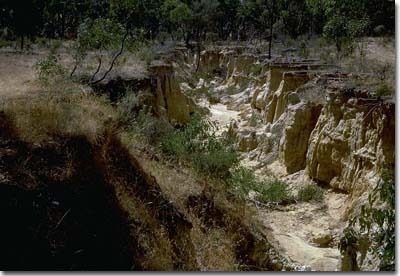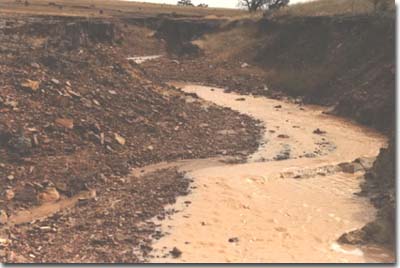Gully Erosion
Land degradation | Water erosion
Distribution of Gully Erosion | Gully Initiation & Development | Gully Reclamation Techniques | Conclusions | References
S.C. Boucher
School of Geography and Environmental Science
Monash University, Victoria 3800
This article has been reviewed by Dr Ian Sargeant.
Introduction
The distinction between various types of channelled water erosion used in this set of articles on land degradation is made under the topic of tunnel erosion. Gullies are open erosion channels at least 30 cm deep which conduct ephemeral runoff and are frequently characterized by steep sidewalls and a lack of vegetation (e.g. Ford et al., 1993; Boucher and Powell, 1994). Although rills are of a shallower depth than gullies (e.g. Graham, 1984; Rosewell et al., 1991), unless destroyed by cultivation they may evolve into the latter type of erosion landform as a result of further runoff-producing rainfall (Gillespie, 1981; Fitzpatrick et al., 1994).
This distinction between rills and gullies regarding the depth of incision was also used for the Australian Soil and Land Survey Field Handbook (McDonald et al., 1984). However, other researchers have defined open channel erosion types using different criteria (Gregory and Walling, 1973; Bocco, 1991); for example with respect to the distinction made between rills and ephemeral channels as well as differences between gullies and arroyos (Bull and Kirkby, 1997). Various terms synonymous with gullies include dongas in South Africa (e.g. Rienks et al., 2000) and others listed by Zachar (1982).
| Rill system This is historic footage of a rill system near Darraweit Guim taken 40 years ago by Lindsay Milton. This silent video clip runs for 35 seconds and is 1.5MB in size, this will take some time to automatically download if you are using a slow internet connection. Click the 'play' button and the video should display directly in your browser, if this does not happen you need to update the 'Adobe Flash Player'. This software can be downloaded for free from the Adobe website (external link). | Rill system (Erosion) 0 seconds of 35 secondsVolume 90% Press shift question mark to access a list of keyboard shortcuts Keyboard Shortcuts Shortcuts Open/Close/ or ? Play/PauseSPACE Increase Volume↑ Decrease Volume↓ Seek Forward→ Seek Backward← Captions On/Offc Fullscreen/Exit Fullscreenf Mute/Unmutem Decrease Caption Size- Increase Caption Size+ or = Seek %0-9 |
| Many of the negative impacts of gully erosion are similar to those produced by tunnelling (see tunnel erosion); for example, where tunnels are located in gully walls or heads they can be used as shelter by rabbits. Apart from the apparent loss of soil and nutrients, there are numerous other on-site effects of gullying, such as reduced trafficability resulting from paddock dissection (Graham, 1984) and associated managment problems including those relating to stock. Gillespie (1981) noted that this type of land degradation at the head of Bango Creek (New South Wales) in 1915 required the use of an alternative road in the area, and Strom (1940) pointed out that it is often necessary to construct bridges or culverts where roads and tracks are affected. |  Gully erosion in the Parwan Valley. Photograph: Ian Sargeant. | |
| In Landcare Note LC0093, Ziebell and Richards (1999) mentioned impacts involving diminished property values and amenity caused by damage to farm improvements (e.g. fences and tracks). Examples of off-site effects are the spoil from a gully near Campbelltown (north-central Victoria) which often made a road impassable (Figure 8 in Forster and Clark, 1940), downstream sedimentation of waterways, dams and lower paddocks (Ziebell and Richards, 1999) as well as the transportation of contaminants from agricultural catchments (Cox and Ashley, 2000). |  Turbid runoff in a subcatchment gully following a storm in November, 1983 near Costerfield. Photograph: Stuart Boucher. |


